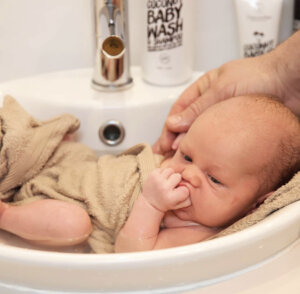Baby’s First Bath – Why you should wait
Baby’s first bath is a really exciting milestone for many. However, my first tip in bathing your newborn is DONT. Unless you have a worse than usual poonami situation going on then it’s not necessary to give your baby a bath in (at least) the first week. A good old ‘Top ’n’ Tail’ will do. Here’s why…
Nourishing Vernix
That icky, cheesey white coating that they are covered with is called ‘vernix’ if I could bottle it up and sell it as a moisturiser I could quit my job as Midwife now. It is a natural moisturiser and forms a barrier on the skin to protect against infection. So as tempting as it is to give them that first bath, don’t wash it off.
Baby’s Temperature
Newborns struggle to regulate their body temperature. Have you ever seen a baby with goose pimples when they are cold? Baby’s can’t shiver to warm up like adults do. When a baby is cold they use their (brown) fat stores to heat themselves. Some baby’s have less brown fat than others, especially if your baby was born early or was a low birthweight. Exposing a newborn to water will cause heat to evaporate off their body making them cold.
Skin Sores
Due to the way babies are still in the fetal position in the early days, it makes it harder to dry a baby properly. This can cause skin sores in hard to reach places such as their armpits, in their neck folds and around their umbilical cord.
When should I bath my baby?
When you are ready to bath your baby, whether that be after the first week, after a month or after the first few days, here are my top tips on bathing a newborn…
Baby’s First Bath: Top Tips
- Definitely leave bathing for at least 24 hours to give the vernix the chance to be absorbed.
- Fill the bath to its max level with cool boiled water. Check temp with your elbow, it shouldn’t feel too hot or too cold.
- Preparation is key to success. Get everything ready, cotton wool, towels, clothes and nappy.
- Hold off the products for the first 6 weeks. Yes they smell yummy but anything other than water upsets the pH balance on their skin.
- Face first. We are a cotton wool companies dream as we say say one piece per wipe. So wipe the eye from inner eye to outer, then get another piece whether you are doing a different eye or the same. One wool for one wipe. Prevents against infection. Then dry baby’s face.
- If they’re not overly keen, put them in the bath for a short amount of time. Even if they are calm, I wouldn’t over do it. Short baths are key.
- Make sure baby is dry paying particular attention to any crevices; under the neck, armpits, groin and the umbilical cord. Bacteria likes wet, dark places.
- Get them dressed, swaddle in a towel then if needed, cradle them over the bath supporting their head and neck to wash their hair. This way they are not losing so much heat from both their head and body being exposed at the same time. Towel dry their head/hair, again to avoid losing heat.
- Then give your baby a big snuggle as they probably cried a lot!
- Get your partner or hubby to take some snaps as you enjoy the precious first time bath, it really is a memory you’ll look back on fondly – even if they cried!
My best bath tip for a baby that cries in the bath…
Put a warm wet flannel or muslin square on baby’s tummy in the bath. You can even try swaddling them in a large muslin square, below their armpits so their arms are out, then bath baby with the swaddle still on. The warmth and security of the swaddle or the flannel gives you enough time to give baby a little dip. See photo below by @the_bambyleabrood.

Bathing your baby is covered in the baby and postnatal online course, along with feeding baby, colic, reflux, baby sleep, your postnatal body and much more.
If you’re current swotting up in preparation for life with a new born, we have loads of helpful blogs. Take a read of 10 Things That Affect Your Breast Milk Supply or Driving your new baby home from hospital.
Featured Image @mywildhaven